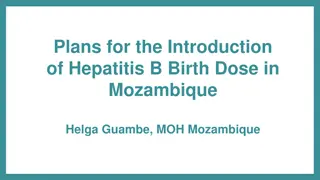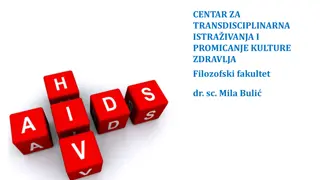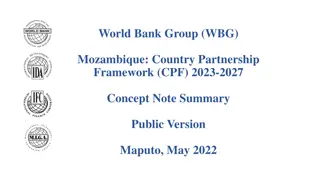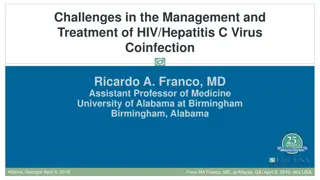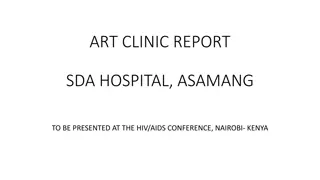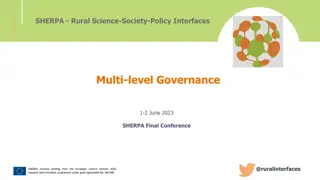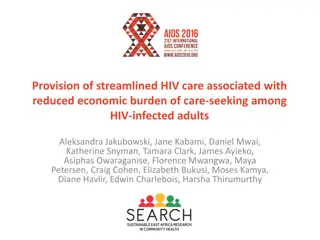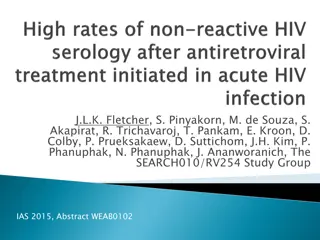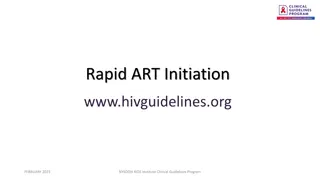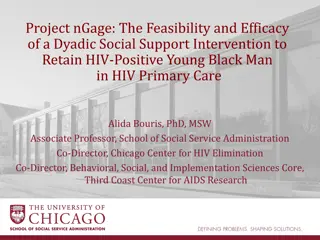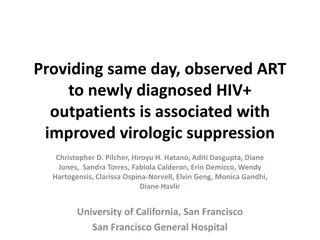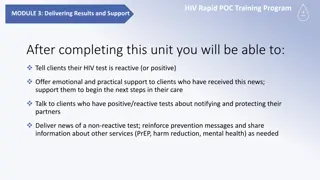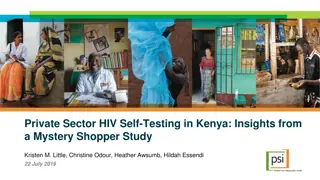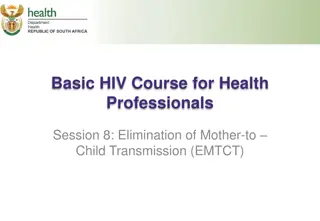Enhancing HIV Care: Community ART Groups in Rural Mozambique
Learn about the impact of Community ART Groups (CAG) on HIV patients in rural Mozambique, improving retention and support. Study objectives focus on group comparisons and health outcomes.
Download Presentation

Please find below an Image/Link to download the presentation.
The content on the website is provided AS IS for your information and personal use only. It may not be sold, licensed, or shared on other websites without obtaining consent from the author. Download presentation by click this link. If you encounter any issues during the download, it is possible that the publisher has removed the file from their server.
E N D
Presentation Transcript
The value of Community ART Groups (CAG) The value of Community ART Groups (CAG) for HIV patients on ART in rural northern for HIV patients on ART in rural northern Mozambique Mozambique L.F. Jefferys L.F. Jefferys1 1, J. Hector 1SolidarMed, Pemba, Mozambique, 2SolidarMed, Lucerne, Switzerland, 3University of Bern, Institute of Social and Preventive Medicine, Bern, Switzerland , J. Hector1 1, M.A. Hobbins , M.A. Hobbins2 2, J. Ehmer , J. Ehmer2 2, N. Anderegg , N. Anderegg3 3 www.solidarmed.ch 1
Background Background Mozambique has 1.5 million people living with HIV* HIV prevalence 11.5%* Anual deaths due to HIV: 45,000* 60% coverage of ART In 2013, MOH recommended the implementation of CAG in Mozambique as a strategy to improve retention of patients in HIV treatment and care *UNAIDS 2014 Global AIDS response programme report 2014 www.solidarmed.ch 2
Community ART Groups (CAG) Community ART Groups (CAG) Rotate monthly clinic visits among members Receive medication for all group members Receive medication for all group members Reduce time and money spent on attending consultations Form a social network within a community to reduce stigma and increase available support and empowerment Up to 6 people can join a CAG Voluntary partication Eligibility criteria: Age>15 years, CD4 >200, Non-pregnant, clinical status www.solidarmed.ch 3
District of Ancuabe, Mozambique District of Ancuabe, Mozambique Retention of patients in ART: 6 months 76%, 1 year: 69% www.solidarmed.ch 4
Implementation of CAG in Ancuabe Implementation of CAG in Ancuabe Lay counsellors provide information whilst patients are waiting for their clinic appointment Interested people from the same village can group together, after eligibilty screening by counsellor Followed up by counsellor in the community A medical officer supervises the work of the lay counsellors www.solidarmed.ch 5
Study Objectives Study Objectives 1. Who are joining the CAG ? Comparison between CAG and non- CAG. 2. Is there an association of being in CAG with improved health outcomes? www.solidarmed.ch 6
Selection of eligible patients Selection of eligible patients 3082 3082 patients starting ART 2010-2015 in Ancuabe 1624 1624 patients meeting eligibility critera (age, non-pregnant, follow up >6 months) 1306 1306 patients with values for variables 180 180 joined a CAG 1126 1126 did not join a CAG www.solidarmed.ch 7
Baseline characteristics Baseline characteristics All All (N=1306) (N=1306) CAG CAG (N=180) (N=180) Non CAG Non CAG (N=1126) (N=1126) Sex [N(%)] Sex [N(%)] male female 484 (37%) 822 (63%) 53 (29%) 127 (71%) 431 (38%) 695 (62%) 33.1 (26.2-41.3) 35.2 (28.4-45.2) 32.9 (26.0-40.9) Median age (IQR) [years] Median age (IQR) [years] 257 (149-352) 261 (175-362) 256 (146-351) Median CD4 cell count Median CD4 cell countat ART initiation (IQR) [cells/ L] initiation (IQR) [cells/ L] at ART WHO stage WHO stageat initiation [N(%)] at initiation [N(%)] 1 2 3 4 313 (24%) 298 (23%) 535 (41%) 160 (12%) 33 (18%) 41 (23%) 78 (43%) 28 (16%) 280 (25%) 257 (23%) 457 (41%) 132 (12%) 23 (6-49) 21 (8-41) 24 (6-49) Median Mediand days late in the 1st 6 ays late in the 1st 6 months of treatment (IQR) months of treatment (IQR) www.solidarmed.ch 8
Associations with CAG participation Associations with CAG participation OR OR 95% 95%- -CI CI p p- -value value Sex [N(%)] Sex [N(%)] male female 1 1.72 (1.22-2.48) 0.021 1.02 (1.01-1.03) 0.005 Age (per 1 Age (per 1- -year yearincrease) increase) 0.99 (0.91-1.07) 0.681 CD4 cell count CD4 cell countat ART initiation at ART initiation (per 100 cells/increase) (per 100 cells/increase) WHO stage at initiation [N(%)] WHO stage at initiation [N(%)] 1 2 3 4 1 1.32 1.49 1.72 0.105 (0.81-2.12) (0.97-2.34) (0.99-2.99) 0.96 (0.91-1.01) 0.160 Days late in the 1st 6 months Days late in the 1st 6 months (per (per10 day increase) 10 day increase) Statistical method: Multivariable logistic regression www.solidarmed.ch 9
Outcomes: Medication refills Percentage of time without medication P=0.01 www.solidarmed.ch 10
Outcomes: Response to ART P=0.01 P= 0.07 234 134 128 95 www.solidarmed.ch 11
Survival and Retention in Care Survival and Retention in Care *LTFU was defined as having no visit >6 months prior to database closure *During 3035 person years of follow up www.solidarmed.ch 12
Survival and Retention in Care Survival and Retention in Care CAG-participation was associated with a 55.1% reduction of the risk of mortality (adjusted hazard ratio [aHR] 0.449, 95%CI 0.264- 0.762) CAG-participation was associated with a 84.3% reduction of the risk of LTFU (aHR 0.157, 95%CI 0.086-0.288) Cox proportional hazards models Adjusted for sex, age, CD4 and WHO stage at baseline, and adherence during 1st6 months of treatment www.solidarmed.ch 13
Conclusion Conclusion Patients who joined a CAG were better attenders and had better health outcomes We should focus on attracting more men into CAG These findings support the use of CAG to improve retention in care and health outcomes in rural settings We still need strategies to improve retention in care for pregnant, lactating women and children www.solidarmed.ch 14
Thank you Thank you www.solidarmed.ch 15



